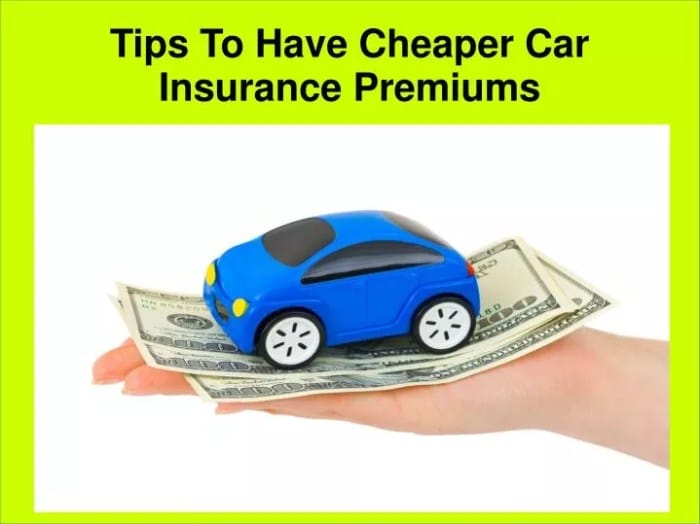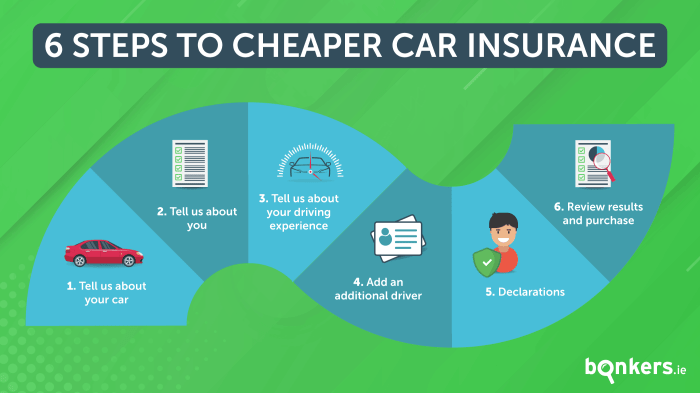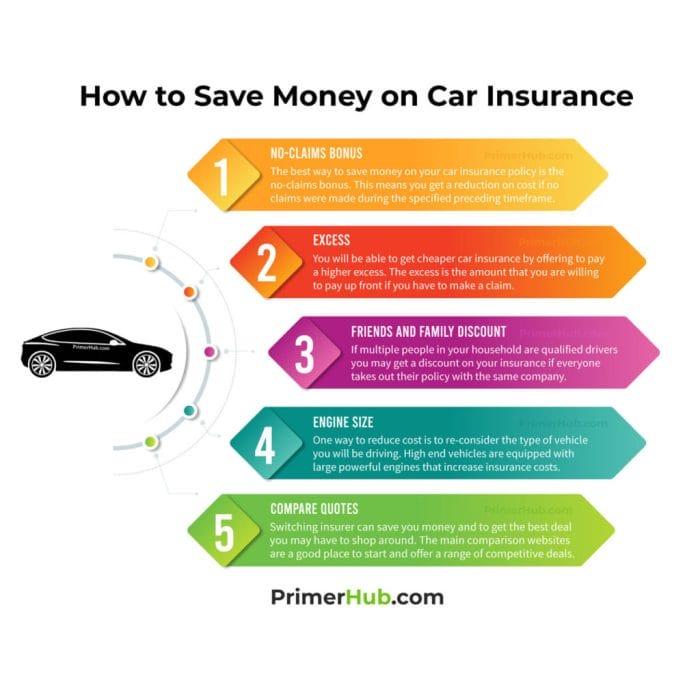Buckle up and prepare for a journey into the world of car insurance, where navigating the complexities can be daunting, especially for new drivers. We’ll unveil the secrets to securing cheaper car insurance, empowering you with knowledge to make informed decisions and save money.
With rising costs and a plethora of insurance options, finding affordable coverage can seem like a maze. Fear not, as we unravel the intricacies, guiding you towards a path of financial prudence. Buckle up, grasp the wheel, and let’s embark on this informative expedition.
Understanding Insurance Rates for New Drivers

New drivers often face higher insurance rates due to their limited driving experience and increased risk of accidents. Several factors influence insurance rates for new drivers, including age, driving experience, and vehicle type.
Insurance companies consider age to be a significant factor when determining rates. Younger drivers, typically those under the age of 25, are more likely to be involved in accidents and have higher insurance rates. This is because they have less experience behind the wheel and may be more prone to risky driving behaviors.
Driving Experience
Driving experience is another critical factor that affects insurance rates for new drivers. Drivers with more experience are generally considered to be safer and less likely to file claims, leading to lower insurance rates. As new drivers gain experience and demonstrate safe driving habits, their insurance rates may decrease over time.
Vehicle Type
The type of vehicle a new driver operates can also impact their insurance rates. Sports cars, high-performance vehicles, and luxury cars typically have higher insurance rates than sedans, minivans, and other standard vehicles. This is because these vehicles are often more expensive to repair or replace in the event of an accident.
Safety First
When it comes to car insurance, maintaining a clean driving record is crucial for new drivers. It demonstrates responsibility, which insurance companies reward with lower rates. On the other hand, traffic violations and accidents can significantly increase insurance costs.
Traffic violations such as speeding, running red lights, and driving under the influence of alcohol or drugs are red flags for insurance companies. These offenses indicate a higher risk of accidents, which leads to higher insurance rates. Similarly, accidents, whether at-fault or not, can also result in increased premiums.
Avoiding Costly Incidents
To avoid costly incidents and keep insurance rates low, new drivers should prioritize safe driving habits. This includes:
- Adhering to Speed Limits: Always drive within the posted speed limit. Speeding is one of the leading causes of accidents.
- Avoiding Distractions: Keep your focus on the road. Avoid using mobile phones, eating, or engaging in other distracting activities while driving.
- Following Traffic Signs and signals: Pay attention to traffic signs and signals. Failure to yield or running red lights can lead to accidents.
- Avoiding Aggressive Driving: Avoid tailSTRUCTUREgaiting, cutting off other drivers, or engaging in aggressive maneuvers. These behaviors increase the risk of accidents.
- Regular Maintenance: Keep your car in good condition. Regular maintenance can help prevent breakdowns and accidents.
Vehicle Selection: Choosing a Cost-Effective Car

Choosing the right car can significantly impact your insurance premiums. Consider the following factors to select a car that is affordable to insure:
Affordability
- Vehicle Value: Opt for a car with a lower purchase price, as this will result in lower premiums. Higher-priced vehicles attract higher premiums due to the increased risk of theft or damage.
- Make and Model: Research different car makes and models to compare insurance rates. Some vehicles are known to have lower insurance costs due to their safety features, reliability, and theft rates.
- Engine Size: Generally, cars with larger engines have higher insurance rates. This is because they are often associated with higher speeds and increased risk of accidents.
Safety Features
- Airbags: Cars equipped with airbags typically have lower insurance rates. Airbags help protect occupants in the event of a collision, reducing the severity of injuries and potential claims.
- Anti-lock Brakes (ABS): ABS helps prevent wheels from locking during braking, improving control and reducing the risk of accidents. Cars with ABS often have lower insurance premiums.
- Electronic Stability Control (ESC): ESC helps keep the car stable during turns and prevents skids. It can reduce the risk of accidents, leading to lower insurance rates.
Theft Prevention
- Immobilizer: An immobilizer prevents the car from starting without the correct key, making it less attractive to thieves. Cars with immobilizers often have lower insurance rates.
- Alarm System: An alarm system can deter theft and alert authorities in case of an attempted break-in. Cars with alarm systems may have lower insurance premiums.
- Tracking Device: A tracking device allows law enforcement to locate a stolen car, increasing the chances of recovery. Cars with tracking devices may have lower insurance rates.
Comparison Table
| Car Model | Insurance Rate |
|---|---|
| Honda Civic | $1,200 |
| Toyota Corolla | $1,300 |
| Ford Focus | $1,400 |
| Hyundai Elantra | $1,500 |
| Kia Forte | $1,600 |
Note: The insurance rates provided are approximate and may vary depending on individual factors and the insurance company.
Coverage Options

Understanding the various coverage options available for car insurance is crucial for new drivers. Different types of coverage provide different levels of protection, and it’s important to tailor your policy to your specific needs and budget.
There are three main types of car insurance coverage:
Liability Coverage
Liability coverage protects you if you cause damage or injury to someone else or their property while driving. It covers legal expenses, medical bills, and property damage.
Collision Coverage
Collision coverage protects your own vehicle if it is damaged in a collision with another vehicle or object. It covers repairs or replacement of your car.
Comprehensive Coverage
Comprehensive coverage protects your vehicle from damage caused by events other than collisions, such as theft, vandalism, fire, or natural disasters. It also covers damage caused by hitting an animal.
In addition to these three main types of coverage, there are a number of other optional coverages available, such as:
- Medical payments coverage: This coverage pays for medical expenses for you and your passengers, regardless of who is at fault in an accident.
- Uninsured/underinsured motorist coverage: This coverage protects you if you are hit by a driver who does not have insurance or who has insufficient insurance to cover your damages.
- Personal injury protection (PIP) coverage: This coverage pays for your medical expenses and lost wages if you are injured in an accident, regardless of who is at fault.
The cost of your car insurance policy will vary depending on the type of coverage you choose, the amount of coverage you need, and your driving history. It is important to compare quotes from different insurance companies to find the best rate.
| Coverage Type | What It Covers | Cost |
|---|---|---|
| Liability | Damage or injury to others | Varies |
| Collision | Damage to your own vehicle | Varies |
| Comprehensive | Damage from events other than collisions | Varies |
| Medical payments | Medical expenses for you and your passengers | Varies |
| Uninsured/underinsured motorist | Protection from drivers without or with insufficient insurance | Varies |
| Personal injury protection (PIP) | Medical expenses and lost wages if you are injured | Varies |
Discounts and Savings

New drivers can access various discounts and savings to make car insurance more affordable. These opportunities can significantly reduce premiums, making it easier for new drivers to obtain the coverage they need.
Good Student Discounts
Many insurance companies offer good student discounts to new drivers who maintain a certain grade point average (GPA). This discount typically ranges from 5% to 25% and can be applied to both the base rate and the cost of additional coverage options.
To qualify for a good student discount, new drivers must typically provide proof of their GPA from their school or college.
Multi-Car Discounts
New drivers who insure multiple vehicles with the same insurance company may be eligible for a multi-car discount. This discount can range from 5% to 15% and is applied to the base rate of each vehicle insured. To qualify for a multi-car discount, new drivers must typically insure at least two vehicles with the same insurance company.
Loyalty Discounts
New drivers who remain with the same insurance company for a certain period of time may be eligible for a loyalty discount. This discount typically ranges from 5% to 10% and is applied to the base rate of the policy.
To qualify for a loyalty discount, new drivers must typically remain with the same insurance company for at least three years.
Shopping Around

New drivers often pay higher insurance rates due to their lack of experience on the road. However, there are several ways to find cheaper car insurance for new drivers, including shopping around for the best rates.
Obtaining quotes from multiple insurance companies is essential to ensure you get the best possible rate. Different insurers use different rating factors, so it’s important to compare quotes from several companies to find the one that offers you the lowest rate.
Steps to Compare Insurance Quotes Effectively
- Gather Information: Collect necessary information, including your personal details, vehicle details, and driving history.
- Choose Insurance Companies: Select a mix of large national insurers and smaller regional or local insurers for a comprehensive comparison.
- Get Quotes Online: Use online comparison tools or visit individual insurer websites to obtain quotes quickly and easily.
- Compare Coverage and Rates: Carefully review each quote, paying attention to the coverage limits, deductibles, and premiums.
- Consider Discounts: Ask about discounts offered by each insurer, such as good student discounts, multi-car discounts, or bundling policies.
- Read Reviews and Ratings: Check online reviews and ratings from previous customers to assess the insurer’s reputation and customer service.
- Contact an Insurance Agent: If you need assistance understanding the quotes or have specific questions, speak with an insurance agent.
- Make an Informed Decision: Choose the insurance company that offers the best combination of coverage, price, and customer service.
Bundling Policies
Bundling insurance policies is a smart way to save money on your car insurance. When you bundle your car insurance with other policies, such as home or renters insurance, you can often get a discount on your overall premium. This is because insurance companies view you as a lower-risk customer when you have multiple policies with them.
Bundling Car Insurance with Home or Renters Insurance
One of the most common ways to bundle insurance policies is to combine your car insurance with your home or renters insurance. This can save you a significant amount of money on your overall premium. For example, State Farm offers a discount of up to 20% when you bundle your car and home insurance.
Allstate offers a discount of up to 25% when you bundle your car and renters insurance.
Other Ways to Bundle Insurance Policies
In addition to bundling your car insurance with your home or renters insurance, you can also bundle other types of insurance policies. For example, you can bundle your car insurance with your motorcycle insurance, your boat insurance, or your RV insurance.
You can also bundle your car insurance with your life insurance or your health insurance.
Benefits of Bundling Insurance Policies
There are several benefits to bundling insurance policies, including:
- Save money: You can often get a discount on your overall premium when you bundle your policies.
- Simplify your life: Having all of your insurance policies with one company can make it easier to manage your coverage and pay your bills.
- Get better coverage: When you bundle your policies, you may be able to get better coverage at a lower price.
Raising Deductibles: Balancing Cost and Coverage

Understanding the relationship between deductibles and insurance premiums is crucial for new drivers seeking affordable coverage. A deductible is the amount you pay out of pocket before your insurance coverage kicks in. Generally, higher deductibles lead to lower premiums. This trade-off allows you to save money on your monthly payments while taking on more financial responsibility in the event of an accident.
Factors Affecting Deductible Levels
When selecting a deductible, consider these factors:
- Risk Tolerance: Assess your ability to pay a higher deductible if needed. If you’re comfortable with the potential financial burden, a higher deductible may be suitable.
- Financial Situation: Consider your current financial situation. If you have limited funds, a lower deductible may be more manageable.
- Claims History: If you have a history of frequent claims, a higher deductible may be more cost-effective.
- Vehicle Value: For older or less valuable vehicles, a higher deductible may be more appropriate.
Finding the Right Deductible Level
The appropriate deductible level depends on your individual circumstances. Consider the following tips:
- Start with a Higher Deductible: Begin with a higher deductible and adjust it as needed. You can always lower your deductible later.
- Consider Your Savings: Ensure you have enough savings to cover your deductible in case of an accident.
- Consult an Insurance Agent: Discuss your situation with an insurance agent to determine the best deductible level for you.
Usage-Based Insurance

Usage-based insurance (UBI) programs, also known as pay-as-you-drive insurance, offer an innovative approach to auto insurance that can help new drivers save money on their premiums. These programs track driving behavior, such as mileage, driving hours, and braking patterns, and use this data to determine insurance rates.
UBI programs typically involve installing a telematics device in the vehicle, which collects and transmits driving data to the insurance company. The device may also provide feedback to the driver, helping them to improve their driving habits and potentially lower their insurance costs.
Insurance Companies Offering Usage-Based Insurance
Several insurance companies offer UBI programs, including:
- Progressive Snapshot
- Allstate Drivewise
- Liberty Mutual RightTrack
- Metromile Pay-Per-Mile
- State Farm Drive Safe & Save
Success Stories of Drivers Who Saved Money with Usage-Based Insurance
Many drivers have saved money on their auto insurance premiums by using UBI programs. For example, a study by the Insurance Research Council found that drivers who participated in a UBI program saved an average of 15% on their insurance costs.
Another study by the National Association of Insurance Commissioners found that drivers who used UBI programs saved an average of $200 per year on their premiums.
Long-Term Savings: Building a Positive Insurance History
Maintaining a positive insurance history is crucial for securing cheaper car insurance rates over the long term. It demonstrates to insurance companies your responsibility and reliability as a driver, leading to potential discounts and lower premiums.
Maintaining a Clean Driving Record
Your driving record plays a significant role in determining your insurance rates. Avoiding traffic violations, accidents, and DUIs can help keep your record clean, which can result in lower insurance premiums.
Continuous Coverage
Maintaining continuous coverage is another key factor in building a positive insurance history. Having a gap in coverage can increase your rates, even if you have a clean driving record. Therefore, it’s essential to keep your insurance active even when you’re not driving a vehicle.
Tips for Maintaining a Positive Insurance History
-
-*Be a Safe Driver
Obey traffic laws, avoid distractions while driving, and maintain a safe following distance.
-*Report Accidents Promptly
If you’re involved in an accident, report it to your insurance company immediately. Delaying or failing to report an accident can negatively impact your insurance history.
-*Consider Telematics Programs
Some insurance companies offer telematics programs that monitor your driving behavior. These programs can provide discounts for safe driving habits.
-*Shop Around Regularly
Even with a positive insurance history, it’s essential to compare quotes from multiple insurance companies periodically to ensure you’re getting the best rate.
Final Summary

Remember, cheaper car insurance for new drivers is achievable by understanding insurance rates, maintaining a clean driving record, selecting a cost-effective car, tailoring coverage to your needs, utilizing discounts, shopping around, bundling policies, raising deductibles wisely, exploring usage-based insurance, and building a positive insurance history.
Embrace these strategies, and you’ll be cruising towards savings and peace of mind on the open road.
Questions and Answers
Q: Why are insurance rates higher for new drivers?
A: Insurance companies view new drivers as higher risk due to limited experience and increased likelihood of accidents. Age and driving history play significant roles in determining premiums.
Q: How can I maintain a clean driving record?
A: Obey traffic laws, avoid distractions while driving, and maintain a safe following distance. Defensive driving courses can also help you develop safer driving habits.
Q: What type of car should I choose to save on insurance?
A: Opt for a car with a good safety rating, as it may qualify for lower premiums. Consider a smaller, less powerful car, as these are generally cheaper to insure.
Q: What coverage options should I consider?
A: Liability coverage is essential, but you may also want to consider collision and comprehensive coverage for added protection. Weigh the costs and benefits of each option to determine the right coverage for you.
Q: How can I find the best insurance rates?
A: Shop around and compare quotes from multiple insurance companies. Online comparison tools can help you find the most competitive rates. Consider bundling your car insurance with other policies, such as home or renters insurance, to save money.



